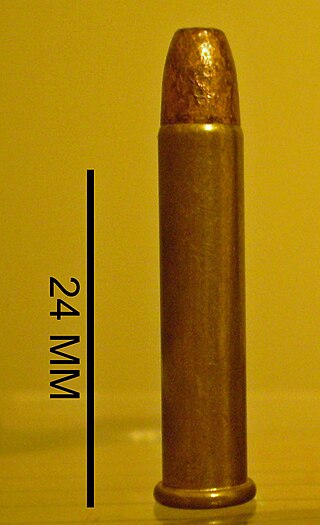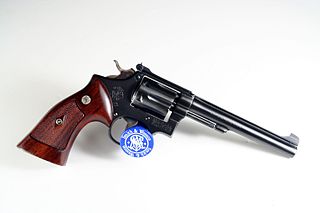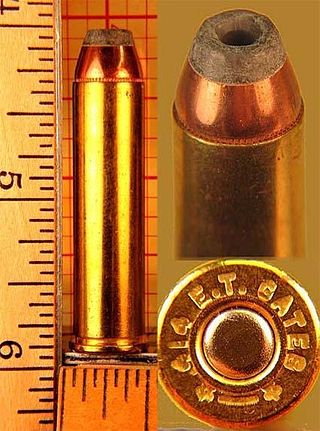
A cartridge, also known as a round, is a type of pre-assembled firearm ammunition packaging a projectile, a propellant substance and an ignition device (primer) within a metallic, paper, or plastic case that is precisely made to fit within the barrel chamber of a breechloading gun, for convenient transportation and handling during shooting. Although in popular usage the term "bullet" is often used to refer to a complete cartridge, the correct usage only refers to the projectile.

The .38 Special, also commonly known as .38 S&W Special, .38 Smith & Wesson Special, .38 Spl, .38 Spc, or 9×29mmR is a rimmed, centerfire cartridge designed by Smith & Wesson.

The .357 Smith & Wesson Magnum, .357 S&W Magnum, .357 Magnum, or 9×33mmR is a smokeless powder cartridge with a 0.357 in (9.07 mm) bullet diameter. It was created by Elmer Keith, Phillip B. Sharpe, and Douglas B. Wesson of firearm manufacturers Smith & Wesson and Winchester. The .357 Magnum cartridge is notable for its highly effective terminal ballistics.

A rim-fire is a type of metallic cartridge used in firearms where the primer is located within a hollow circumferential rim protruding from the base of its casing. When fired, the gun's firing pin will strike and crush the rim against the edge of the barrel breech, sparking the primer compound within the rim, and in turn ignite the propellant within the case. Invented in 1845 by Louis-Nicolas Flobert, the first rimfire metallic cartridge was the .22 BB Cap cartridge, which consisted of a percussion cap with a bullet attached to the top. While many other different cartridge priming methods have been tried since the early 19th century, such as teat-fire and pinfire, only small caliber rimfire cartridges have survived to the present day with regular use. The .22 Long Rifle rimfire cartridge, introduced in 1887, is by far the most common ammunition found in the world today in terms of units manufactured and sold.

The .45 Colt (11.43×33mmR), often called the .45 Long Colt, is a rimmed straight-walled handgun cartridge dating to 1872. It was originally a black-powder revolver round developed for the Colt Single Action Army revolver. This cartridge was adopted by the U.S. Army in 1873 and served as an official US military handgun cartridge for 19 years, before being replaced by the .38 Long Colt in 1892. Although there has never been a ".45 Short Colt" cartridge, the .45 Colt is frequently called the ".45 Long Colt" to better distinguish it from the shorter and less powerful .45 Schofield cartridge, which was also in use around the same time as the .45 Colt.

The .44 Remington Magnum, also known as .44 Magnum or 10.9x33mmR, is a rimmed, large-bore cartridge originally designed for revolvers and quickly adopted for carbines and rifles. Despite the ".44" designation, guns chambered for the .44 Magnum round, its parent case, the .44 Special, and the .44 Special's parent case, the .44 Russian all use 0.429 in (10.9 mm) diameter bullets. The .44 Magnum is based on the .44 Special case but lengthened and loaded to higher pressures for greater velocity and energy.

The .44 Smith & Wesson Special, also commonly known as .44 S&W Special, .44 Special, .44 Spl, .44 Spc, or 10.9×29mmR, is a smokeless powder center fire metallic revolver cartridge developed by Smith & Wesson in 1907 as the standard chambering for their New Century revolver, introduced in 1908.

.22 Short is a variety of .22 caliber rimfire ammunition. Developed in 1857 for the first Smith & Wesson revolver, the .22 rimfire was the first American metallic cartridge. The original loading was a 29 or 30 gr bullet and 4 gr of black powder. The original .22 rimfire cartridge was renamed .22 Short with the introduction of the .22 Long in 1871.

The .22 Long is a variety of .22 caliber (5.6 mm) rimfire ammunition. The .22 Long is the second-oldest of the surviving rimfire cartridges, dating back to 1871, when it was loaded with a 29 gr (1.9 g) bullet and 5 gr (0.32 g) of black powder, 25% more than the .22 Short on which it was based. It was designed for use in revolvers, but was soon chambered in rifles as well, in which it gained a reputation as a small game cartridge.

The .32 S&W Long / 7.65x23mmR, often called the .32 Long, is a straight-walled, centerfire, rimmed handgun cartridge, based on the earlier .32 S&W cartridge. It was introduced in 1896 for Smith & Wesson's first-model Hand Ejector revolver. Colt called it the .32 Colt New Police in revolvers it made chambered for the cartridge.

The .22 Winchester Magnum Rimfire, also known as the .22 WMR, .22 Magnum, .22 WMRF, .22 MRF, or .22 Mag, is a rimfire cartridge. Originally loaded with a bullet weight of 40 grains (2.6 g) delivering velocities in the 2,000 feet per second (610 m/s) range from a rifle barrel, .22 WMR is now loaded with bullet weights ranging from 50 grains (3.2 g) at 1,530 feet per second (470 m/s) to 30 grains (1.9 g) at 2,200 feet per second (670 m/s).

The Smith & Wesson K-22 Target Masterpiece Revolver is a six-shot, double-action revolver with adjustable open sights, built on the medium-size "K" frame. When introduced, it was intended for bullseye target shooting competition of the type then most common on the United States, which is today called NRA Precision Pistol, specifically in the "smallbore" or "22" category. It is chambered for the .22 Long Rifle cartridge. It is one of three similar models that Smith & Wesson offered, the other two being intended for the "centerfire" category, the K-32 Target Masterpiece chambered for the .32 S&W Long cartridge and the K-38 Target Masterpiece chambered for the .38 Special cartridge. Most K-22 revolvers were fitted with a 6 in (150 mm) or 8+3⁄8 in (210 mm) barrel, but other lengths have been produced. First produced in 1947 and originally known as the K-22 Target Masterpiece, it was numbered the Model 17 in 1957 when all Smith & Wesson guns were given numerical model numbers. It is built on the same frame as the seminal Smith & Wesson Model 10 revolver.

The .460 S&W Magnum round is a powerful revolver cartridge designed for long-range handgun hunting in the Smith & Wesson Model 460 revolver.

The .32 H&R Magnum, also known as the .32 Magnum, is a rimmed cartridge designed for use in revolvers. It was developed and introduced in 1984 as a joint venture between Harrington & Richardson and Federal Premium Ammunition.

A handgun is a firearm designed to be usable with only one hand. It is distinguished from a long barreled gun which needs to be held by both hands and braced against the shoulder. Handguns have shorter effective ranges compared to long guns, and are much harder to shoot accurately. While most early handguns are single-shot pistols, the two most common types of handguns used in modern times are revolvers and semi-automatic pistols, although other handguns such as derringers and machine pistols also see infrequent usage.

A super magnum is a longer and/or more powerful version of a "magnum" cartridge. Although the term "super magnum" typically refers to a handgun cartridge, created by lengthening an existing straight-case design, it can also refer to rifle and shotgun cartridges, such as the .17 Winchester Super Magnum and the 31⁄2" 12 Gauge Super Magnum. In this case, it simply denotes that it is of greater power than existing "magnums" of a similar caliber or gauge, this is comparable to other designations, such as the "Remington Ultra Magnum". The most widespread of these cartridges are the "SuperMag" family of super-magnum handgun cartridges that were proposed and tested by Elgin Gates in the 1970s.

.22 caliber, or 5.6 mm, refers to a common firearms bore diameter of 0.22 inch (5.6 mm) in both rimfire and centerfire cartridges.

The .22 Extra Long is a .22 in (5.6 mm) American rimfire rifle and handgun cartridge.

The .32 rimfire / 8x20mmRF refers to a family of cartridges which were chambered in revolvers and rifles in the late 19th and early 20th centuries. These rounds were made primarily in short and long lengths, but extra short, long rifle and extra long lengths were offered.
The .500 S&W Magnum or 12.7×41mmSR is a .50 caliber semi-rimmed revolver cartridge developed by Cor-Bon in partnership with the Smith & Wesson "X-Gun" engineering team for use in the Smith & Wesson Model 500 X-frame revolver and introduced in February 2003 at the SHOT Show. From its inception, it was intended to be the most powerful handgun cartridge to date, with the capacity to harvest all North American game species. While more powerful handgun cartridges, such as the .500 Bushwhacker, have emerged since, they are only available in custom firearms, and the .500 S&W remains the most powerful production handgun cartridge.





















